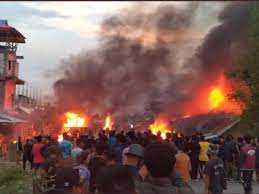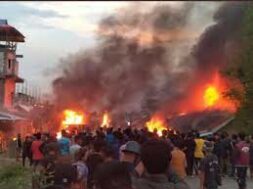
Manas Dasgupta
NEW DELHI, May 4: The Manipur government has issued “shoot at sight” orders in “extreme cases”, imposed curfew in many of the affected areas, strengthened security with the deployment of 55 army columns and the riot-controlling Rapid Action Force companies flown in as violence in the state spread to its capital city of Imphal with over 9,000 people displaced.
Curfew has been imposed in Meitei-dominated Imphal West, Kakching, Thoubal, Jiribam, and Bishnupur districts, and tribal-dominated Churachandpur, Kangpokpi, and Tengnoupal districts. Mobile internet services were suspended across the State.
The order signed by the Manipur Governor on Thursday evening empowered the state’s magistrates to issue “shoot-at-sight orders in extreme cases whereby all forms of persuasion, warning, reasonable force, etc. had been exhausted.”
Around 500 personnel of the Rapid Action Force, a riot control police, have been flown into Imphal. They join the army, Assam Rifles, the Central Reserve Police Force and the state police, who have been struggling to contain the violence that started on Wednesday.
Over the last days, there have been multiple appeals for peace as visuals of houses and shops on fire flooded social media. More than 9,000 people have been evacuated from violence-hit areas by the security forces. A defence spokesperson said around 5,000 people have been shifted to safe homes in Churachandpur, another 2,000 people were shifted in Imphal Valley, and 2,000 people in the border town of Moreh in Tengnoupal district.
The violence started on Wednesday during a protest march by tribals against a Manipur High Court order backing the inclusion of non-tribal Meities in the list of Scheduled Tribes. It had incensed the Naga and Kuki tribals, who comprise less than 40 per cent of the population.
Though Meities comprise 64 per cent of the state’s population, they occupy 10 per cent of the state’s territory as non-tribals are not allowed to buy land in notified hill areas. Their inclusion in the ST category will enable them to purchase land and the possibility has unleashed tribal emotions about land.
To set the process of inclusion of Meities in the ST list, the state government has to write to the Centre. The move, though, can be challenged legally. Earlier during the day, the Chief Minister N Biren Singh said the situation in the state was moving towards normal. “The government is taking all measures to maintain the law and order… We are committed to protecting the lives and property of all our people,” he had said. He also briefed Union home minister Amit Shah about the situation.
The Army also kept some 14 columns on standby for deployment in case the situation flared up once again, a Defence spokesperson said. The Centre, which is monitoring the situation in Manipur, also dispatched teams of the Rapid Action Force (RAF) — a specialised force to handle riots — for deployment in violence-hit areas of the north-eastern State.
Clashes broke out on Wednesday which intensified overnight with counter-attacks being mounted by rival communities in retaliation to earlier attacks after Naga and Kuki tribals organised a ‘Tribal Solidarity March’ to protest moves to give scheduled tribe status to the majority Metei community.
The Army and Assam Rifles staged flag marches in Khuga, Tampa, Khomaujanbba areas of Churachandpur. Flag marches were also carried out in Mantripukhri, Lamphel, Koeirangi area of Imphal Valley, and Sugnu in Kakching district on Thursday, the Defence spokesperson said.
The ‘Tribal Solidarity March’ was organised by the All Tribal Student Union Manipur (ATSUM) in the ten hill districts of the State to protest the demand of non-tribal Meiteis for Scheduled Tribe (ST) status. The march was organised after the Manipur High Court asked the state government last month to send a recommendation to the Centre within four weeks on the demand for ST status by the Metei community.
During the march in Torbung area of Churachandpur district, an armed mob allegedly attacked people of the Meitei community, leading to retaliatory attacks in the valley districts, which escalated the violence throughout the State, according to police. Many shops and houses were vandalised, and gutted in arson that lasted for more than three hours in Torbung, they said.
In the Imphal valley, houses of Kuki tribals were ransacked in several areas, forcing them to flee, police said. Over 500 residents of the Kuki-dominated Langol area in Imphal West fled their homes, and are currently staying at the CRPF camp at Lamphelpat, police said. Some places of worship were also set on fire in the Imphal valley last night, they said.
Meanwhile, around 1,000 Meiteis of the tribal-dominated Churachandpur district fled to various areas of Bishnupur district, including Kwakta and Moirang, they said. Over twenty houses were also burnt in Motbung area of Kangpokpi district, police said. Violence was also reported from Moreh near the Myanmar border in Tengnoupal district.
The opposition has criticised the state’s BJP-led ruling alliance. “In less than 15 months of BJP forming govt, the entire state of Manipur is in flames. But HM Shah and CryPM Modi are busy campaigning in Karnataka,” tweeted Congress’s Jairam Ramesh.
“I am deeply concerned about the situation in Manipur,” tweeted Bengal Chief Minister Mamata Banerjee. “It is not the time for politics. Politics & elections can wait but our beautiful state Manipur has to be protected first. Thus I urge the Prime Minister & Home Minister to first take care of Manipur, restore peace there,” she added.
Lawmakers of the valley have earlier openly endorsed the demand by some Meitei organisation for ST status, alarming communities who figure in the Scheduled Tribe list.
The Meiteis inhabit the valley, which accounts for about a tenth of the former princely state’s land area. They claim they are facing problems because of “large-scale illegal immigration by Myanmarese and Bangladeshis.” The hill districts which account for much of the state’s land are inhabited mostly by tribals — including the Nagas and Kukis who are mainly Christians — and are protected from encroachment by various laws.
Manipur violence has its genesis in the longstanding demand that the Meitei community be included in the list of the state’s Scheduled Tribes (ST), which received a boost from an order of the Manipur High Court last month. Both the demand and the order, passed by a single judge of the High Court, have been strongly opposed by groups representing the state’s tribal communities. The court’s order, released on April 14, asking the government to consider the demand, has brought the historical tensions between the valley-dwelling Meitei community and the state’s hill tribes to a boil.
The Meiteis are the largest community in Manipur. There are 34 recognized tribes, which are broadly classified as ‘Any Kuki Tribes’ and ‘Any Naga Tribes’. The central valley in the state accounts for about 10% of the landmass of Manipur, and is home primarily to the Meitei and Meitei Pangals who constitute roughly 64.6% of the state’s population. The remaining 90% of the state’s geographical area comprises hills surrounding the valley, which are home to the recognized tribes, making up about 35.4% of the state’s population.
There has been an organised push in support of this demand for at least since 2012, led by the Scheduled Tribes Demand Committee of Manipur (STDCM). The recent plea before the Manipur High Court was by the Meetei (Meitei) Tribe Union, seeking directions to the Manipur government to submit a recommendation to the Union Ministry for Tribal Affairs for the inclusion of the Meetei/Meitei community in the list of Scheduled Tribes in the Indian Constitution, as a “tribe among tribes in Manipur.”
In their plea before the High Court, the petitioners argued that the Meitei community was recognised as a tribe before the merger of the princely state of Manipur with the Union of India in 1949, and that it lost its identity as a tribe after the merger. It was argued in court that the demand for ST status arose from the need to “preserve” the community, and “and save the ancestral land, tradition, culture and language” of the Meiteis.
In various pleas to the state and central governments, the STDCM has stated that as a result of being left out of the ST list, “the community has been victimised without any constitutional safeguards to date. The Meitein/Meetei have been gradually marginalised in their ancestral land. Their population which was 59% of the total population of Manipur in 1951 has now been reduced to 44% as per 2011 Census data”.
The court observed that “the petitioners and other Unions are fighting long years for inclusion of Meetei/Meitei community in the tribe list of Manipur”, and directed the government to submit its recommendation after considering the case of the petitioners, “preferably within a period of four weeks” of receipt of the order.
The demand for ST status for the Meitei community has long been opposed by the state’s tribal groups. One of the reasons cited for the opposition is the dominance of the Meiteis, both in population and in political representation, since 40 out of 60 Assembly constituencies of the state are in the valley.
“The ST communities of Manipur have been consistently opposing to the inclusion of fearing the loss of job opportunities and other affirmative actions granted to STs by the Constitution of India to a much advanced community like the Meitei,” said Janghaolun Haokip of the Kuki Inpi Manipur, the apex body of Kuki tribes in the state.
Other arguments against the demand have been that the Manipuri language of the Meiteis is included in the Eighth Schedule of the Constitution, and that sections of the Meitei community — which is predominantly Hindu — are already classified under Scheduled Castes (SC) or Other Backward Classes (OBC), and have access to the opportunities associated with that status.
“The claim that Meiteis need ST status to protect their culture and identity is self-defeating. The Meiteis are a dominant group controlling the state and its apparatuses. The state has been protecting their cultural, political and economic rights. As such, their culture and identity are in no way endangered…,” experts said.














